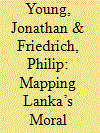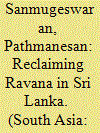| Srl | Item |
| 1 |
ID:
168813


|
|
|
|
|
| Summary/Abstract |
This paper aims to study the history and significance of Vibhishana in Sri Lanka, an important character in the Ramayana, one of the two most renowned classical epics originating from India that became popular in South and Southeast Asia. Although the protagonist of the Ramayana, Rama, along with his spouse Sita and ardent ally Hanuman, are venerated throughout Hindu and Buddhist South and Southeast Asia, a Vibhishana cult is only found in Sri Lanka. How this came about is the central question investigated in this paper. Towards this end, historical and cultural factors specific to Sri Lanka are interrogated to tease out the circumstances that have contributed to Vibhishana’s divinity. Representations of Vibhishana in literature, art and temple worship are scrutinised to problematise Vibhishana’s significance within the Buddhist religious cosmos and his continued relevance even during the recent emergence of the cult of Ravana, his mighty older brother in the Ramayana.
|
|
|
|
|
|
|
|
|
|
|
|
|
|
|
|
| 2 |
ID:
168814


|
|
|
|
|
| Summary/Abstract |
This article analyses the ways in which a little-known Sinhala text called the Ravana Rajavaliya articulates a moral topography of late medieval Sri Lanka. Rather than expressing a kind of all-consuming xenophobia in response to social and cultural difference, the text indexes a set of local political responses to the surge in social mobility occasioned by changing patterns of trans-regional circulation in Sri Lanka’s southwest. We argue that ‘others’ are represented in terms of proximity to a generalised moral order, one which highlights desirable forms of selfhood as instruments for assimilation within an emerging state society.
|
|
|
|
|
|
|
|
|
|
|
|
|
|
|
|
| 3 |
ID:
168815


|
|
|
|
|
| Summary/Abstract |
By examining the public discourse on Ravana that has been widespread among Sinhalese in the recent past, this paper suggests that the Sinhala nation is perhaps on the verge of being redefined. In comparison to the origin story of the Sinhalese that remained seriously unchallenged till the end of the twentieth century, in which the Sinhalese were considered the descendants of the Aryan prince Vijaya who arrived on the island around 2,500 years ago, this new narrative identifies the yakkha king Ravana as the originator of the Sinhala nation by going further back into the past. The paper also attempts to explain why this surge of interest in Ravana is taking place at this particular moment and not earlier.
|
|
|
|
|
|
|
|
|
|
|
|
|
|
|
|
| 4 |
ID:
168816


|
|
|
|
|
| Summary/Abstract |
This paper considers the appropriation of Ravana, the demon-king antagonist of the famed Ramayana epic, as a Sinhala Buddhist cultural hero in the context of twenty-first-century, post-war Sri Lanka. We highlight the irony of the recent Buddhist appropriation of Ravana as a signifier of indigeneity and sovereignty, given that he has already been employed in this capacity in the Tamil Hindu context for nearly a century. We note several convergences between the ‘Sinhala Ravana’ phenomenon and its Tamil counter-narrative, including a shared archive of textual material invoked as evidence, the introduction of alleged physical evidence as proof of Ravana’s historicity, and a sympathetic outlook on Ravana’s character, emphasising his qualities as a learned and righteous king.
|
|
|
|
|
|
|
|
|
|
|
|
|
|
|
|